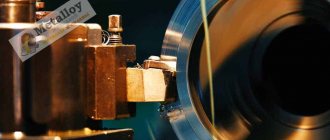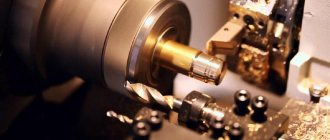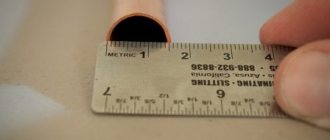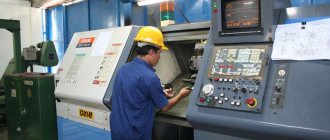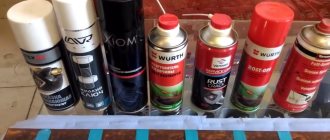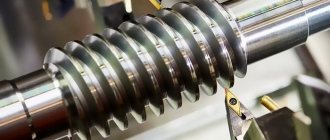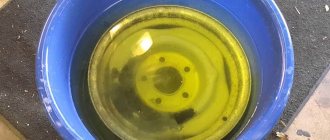Metals are used almost everywhere. The main problem with these materials is that they are susceptible to corrosion. Rust gradually destroys the structure of the part and renders it inoperable. To avoid destruction of the material, anti-corrosion treatment is carried out. Processing can be carried out not only in production, but also at home.
Anti-corrosion metal treatment
Preventive actions
To prevent the harmful effects of corrosion, it is recommended to use special chemical protection agents. These agents include inhibitors, which are substances that slow down or completely stop a particular chemical process. As a result of the action of the inhibitor, a thin coating in the form of a protective film appears on the surface of the material. It is this film that protects the metal from rusting.
One of the most popular inhibitors today is “Rust stop”. The drug has a penetrating effect, as a result of which moisture is removed from the material and a polymolecular layer is created on the surface. The product is non-toxic and easy to use.
Direct and indirect problems associated with metal corrosion
The main problem with corrosion is the gradual destruction of corroded parts of structures and products. At the same time, the degree of damage cannot always be assessed by appearance, and the loss of strength becomes unexpected and critical.
Intercrystalline corrosion, that is, passing along the boundaries of crystals, is especially strong. Externally, the process may be completely unnoticeable, while the level of strength loss reaches 50...60%.
Surface destruction has the least impact on the strength properties of products.
The photo shows part of the structures of the Shukhov Tower in Moscow. Surface rusting has significantly reduced structural strength, but has not led to the destruction of the structure (yet)
It is extremely difficult to estimate the level of losses from metal corrosion. The point is not even in direct losses from the destruction of corroded parts or structures, but in downtime of equipment and structures and disruptions in their performance as a whole, associated with the corrosion destruction of individual elements.
Mechanical removal
To mechanically treat rust, you will need a metal brush or coarse abrasive sandpaper. Using sandpaper, you can clean the material using the “dry” method or the “wet” method (wetting the sandpaper with kerosene or white spirit).
Other mechanical cleaning options include the use of the following hardware:
- orbital sander with abrasive wheels;
- sandblasting machine;
- electric drill attachments;
- Bulgarians.
The use of manual means (brush or sandpaper) is justified on small surfaces. The advantage of working the surface by hand is that it allows you to go more thoroughly into small or hard-to-reach areas.
An attachment to an electric drill, grinder or grinder can speed up surface cleaning significantly. However, such methods are not highly accurate: too much metal is removed.
Sandblasting equipment is the best way to remove rust.
Removal of corrosive products occurs by treating the metal with a powerful jet of sand. In this case, the undamaged metal completely retains its structure.
The disadvantage of this method is the high cost of new equipment.
Chemical methods
Chemical methods involve the use of the following groups of drugs:
- rust converters;
- acids (primarily phosphoric acid);
- folk remedies.
Orthophosphoric acid
This substance is a classic solvent and is included in many rust control products.
The method of using phosphoric acid is described below:
- The substance is applied in a thin layer to the area affected by corrosion.
- Next you need to wait for 30 minutes until the reaction is completed.
- The procedure is completed by wiping the treated surface dry.
Phosphoric acid removes traces of rust and also promotes the formation of a phosphate water-repellent film. This film slows down the process of metal oxidation, preventing further development of the corrosion process.
To remove rust, use a 30% acid solution. The advantage of orthophosphoric acid compared to other acids (for example, sulfuric acid) is that it has a more gentle effect on the metal.
Rust converters
The principle of rust conversion products is to convert corrosive products into a harmless or protective layer, which can then be treated with paint or varnish.
Listed below are the most famous rust converters available on the market:
- VSN-1. After applying this acid neutralizer, the treated area turns gray. All that remains is to wipe off the stain with a dry cloth along with any remaining rust.
- Spray aerosol based on zinc “Zinkor-Auto”. This product is a degreasing solution that can remove traces of corrosion from a metal surface. After applying the solution, a protective film is formed on the surface.
- Rust converter SF-1. The composition is made on the basis of phosphates. Used to treat steel, cast iron, aluminum and galvanized surfaces before applying varnish or paint. The modifier has an inhibitory effect, since the film that appears on the metal after its processing extends the service life of the painted surface by 10-12 years.
- Rust modifier "Berner". The drug has a deoxidizing effect. The basis of the modifier is molybdenum. The product is effective even on heavily rusted surfaces. For example, the converter is used to process rusty bolts that cannot be removed using standard means. Available in spray form.
- Anti-corrosion agent B-52. This acid modifier is available in gel form. Its main advantage is the lack of spreading over the surface. After the rust has dissolved, the remaining gel is washed off the metal.
Corrosion of zinc in acids
Both zinc of ordinary purity and its oxide corrode when in contact with acids. Very pure zinc does not react with solutions of acids and alkalis even when the temperature rises. The reaction begins only when copper sulfate (CuSO4) is added. Corrosion of zinc is also observed in solutions of alkaline and acidic salts.
In acids and acidified environments, zinc corrosion occurs with hydrogen depolarization, i.e. release of hydrogen.
Corrosion of zinc in hydrochloric acid proceeds intensively, with the formation of zinc chloride and the release of hydrogen according to the reaction:
Zn + 2HCl → ZnCl2 + H2↑.
One of the uses of hydrochloric acid is precisely the production of zinc chloride.
Corrosion of zinc in sulfuric acid also occurs quite intensively, with the formation of zinc sulfate and the release of hydrogen according to the reaction:
Zn + H2SO4(dil.) → ZnSO4 + H2↑.
Line of anti-corrosion products "WD-40"
The American company produces a popular line of anti-corrosion products on the market - “WD-40”. The drugs are widely used by both professionals and home craftsmen.
The line includes five products: long-lasting inhibitor, protective lithium grease, waterproof silicone grease, spray and rust removal solution.
Long acting inhibitor
The drug is used for year-round protection of metal products located outdoors. The manufacturer guarantees rust protection for two years if the product is located indoors, and for outdoor items the warranty extends for a year.
The composition is a spray that includes a vapor-phase anti-corrosion inhibitor, which creates a protective layer on the metal surface, preventing direct contact of the material with air and moisture. The inhibitor is recommended to be used to protect locks, gas cylinders, working tools, door hinges, process chains and cables, steel doors, and automotive parts. The drug can also be used to treat any other items that are used in conditions of high humidity.
Protective white lithium grease
The drug is applied to the metal for the purpose of preventive protection, that is, in essence it is an inhibitor. A thin protective film forms on the surface. Moreover, the film is not washed off by precipitation, does not melt in the sun and does not freeze in cold weather.
The drug is available in the form of a spray and is recommended for treating door hinges or guides, chains and sprockets of mechanisms, cables and racks.
In addition, lithium grease is often used to preserve products placed in a warehouse for long-term storage.
Waterproof silicone grease
A characteristic feature of the lubricant is its ability to dry quickly. It is also worth noting that the lubricant leaves virtually no traces after lubricating the parts. In addition to the described areas of use for inhibitors, silicone grease is recommended for treating moving mechanisms. The lubricant does not contain petroleum products, and therefore does not damage rubber, plastic and vinyl surfaces. After drying, a transparent, non-sticky coating is formed.
Rust remover spray
The spray is based on the capillary principle, according to which the liquid moves through small channels and cracks, despite the force of gravity. Due to this feature, the spray is suitable for treating hard-to-reach areas where it is difficult to remove rust even by hand.
The spray can not only remove rust, but also act as an inhibitor, preventing its reappearance in the future. The drug is used to treat heavily rusted surfaces, including bolts and threaded connections. The spray is safe for non-metallic surfaces.
Rust removal solution
The contents of the solution consist of non-toxic elements that are biodegradable. The solution is designed to remove the effects of corrosion from surfaces. To clean rust from metal, the part is immersed in a container with a solution for 3-4 hours. If the product is heavily rusted, the procedure will take 7-8 hours. The solution is suitable for both processing miniature parts and cleaning large items (if an appropriate container is available).
Rust control methods
There are several methods that can extend the life of iron parts and objects. The most effective way is chemical treatment. These include inhibitor compounds that coat metal objects with a thin film. It is this that allows you to protect the product from destruction. Such drugs are often used for preventive purposes.
Let's look at the main methods to prevent corrosion:
- mechanical rust removal;
- chemical treatment;
- anti-corrosion substances;
- folk remedies for rust.
Mechanical cleaning
To perform mechanical anti-corrosion treatment manually, you need to purchase a metal brush or coarse abrasive sandpaper. Items can be processed dry or wet. In the first option, the rust is usually scraped off, and in the second, the skin is wetted in a solution of white spirit or kerosene.
You can also mechanically clean rusting materials using hardware, such as:
- Bulgarian.
- Sander.
- Electric drill with a metal brush attachment.
- Sandblasting machine.
Of course, you can clean the surface more thoroughly by hand. But it is used in small areas. Hardware materials will speed up the workflow, but they can also harm the parts. During processing, a large layer of metal will be removed. The best option that will carefully remove corrosion is a sandblasting machine. Such equipment has its own small drawback - high cost.
When processing objects with sandblasting equipment, the metal surface is not ground down, but retains its structure. A powerful jet of sand gently removes rust.
Treatment with chemicals
Chemicals are divided into two groups:
- Acids (the most popular is phosphoric acid);
- Rust converters.
Acids often mean ordinary solvents. Some of them have an orthophosphorus composition, which allows you to restore rusting material. The method of using acid is quite simple: wipe the iron or metal from dust with a damp cloth, then remove any remaining moisture, apply a thin layer of acid to the object with a silicone brush.
The substance will react with the damaged surface, leave it for 30 minutes. When the part is cleaned, wipe the treated area with a dry cloth. Before using anti-rust chemicals, wear protective clothing. While working, make sure that the composition does not come into contact with exposed skin.
Orthophosphoric acid has a number of advantages over other compounds. It is gentle on metal objects, removes rust and prevents the appearance of new areas of infection.
Rust converters are applied to the entire metal surface, thereby forming a protective layer that will subsequently prevent corrosion of the entire item. After the composition has dried, you can open it with paint or varnish. Today, a large number of converters are produced in the construction industry, the most popular of which are:
- Berner rust modifier. Designed for processing bolts and nuts that cannot be dismantled.
- Rust neutralizer VSN-1. Used in small areas. Neutralizes rusty areas, forming a gray film that can be easily wiped off with a dry cloth.
- Aerosol "Zinkor". The degreasing composition allows you to restore rusted objects and forms a protective film on the surface.
- B-52 rust destroyer. This is a fast-acting gel, does not spread, and removes all types of corrosion.
- Converter SF-1. Used for cast iron, galvanized, aluminum surfaces. Removes rust, after treatment protects the material, extends its service life up to 10 years.
Most anti-corrosion substances consist of toxic chemical compounds. Make sure you have a respirator. This way you will protect the mucous membranes of the respiratory tract from irritation.
Application of anti-corrosion compounds
One of the leading chemical companies offers a wide range of anti-corrosion products. But the most effective is considered to be a line of five substances:
- Long acting inhibitor. Metal products treated with the substance can be outdoors all year round. At the same time, they are protected from any weather influences that provoke a corrosion process.
- Protective lithium grease. The material is applied to the surface to protect and prevent rusting. It is recommended for application to door hinges, chains, cables, and rack and pinion mechanisms. Forms a protective film that is not washed off by precipitation.
- Waterproof silicone grease. Thanks to its silicone composition, the lubricant is applied to metal surfaces with elements of plastic, vinyl and rubber. Dries quickly, forms a thin, transparent, non-sticky coating.
- Anti-rust spray. The drug is used to treat hard-to-reach places, is intended for deep penetration, and protects products from the reappearance of rust. Widely used for anti-corrosion treatment of threaded connections and bolts.
- A solution that removes corrosion stains. The solution contains non-toxic substances. It can be used both for processing building materials and various kitchen utensils. How to prevent a knife from rusting? Feel free to treat it with the solution, leave it for 5 hours, then wash it well with detergent. And the knife is ready for use again.
On video: WD-40 rust destroyer.
Traditional methods of removing rust
In addition to factory-made preparations, so-called folk recipes can be used to remove rust. Most often we are talking about the drink “Coca Cola”, the cleaning product “Cilit” or a mixture of kerosene and paraffin.
Below is more information about each of the tools:
- The effectiveness of the Coca Cola drink against rust is associated with the presence of orthophosphoric acid in the drink. To remove rust, you need to apply the drink to the problem area. You can use a soaked rag or a piece of foil. The method of immersion in a container with a drink is also used.
- "Cilit" is often used to remove rust from household appliances in bathrooms and kitchens. At the same time, the cleaning agent can be used to remove traces of corrosion on other metal objects, for example, car parts. However, it should be borne in mind that this product can corrode paint.
- You can also clean the surface from rust with a solution of kerosene and paraffin in a ratio of 10 to 1. Before use, the composition must be kept for 24 hours. Next, the mixture is applied to the rusty area for 12 hours. The procedure is completed by cleaning the surface with a rag.
When handling chemicals, safety precautions must be observed. First of all, it is necessary to protect the skin, respiratory and vision organs from hazardous particles. You will need a respirator, safety glasses and gloves.
How to do the treatment yourself?
There are various ways to protect metal from corrosion that can be used at home. They do not require the use of expensive equipment and powerful chemical compounds.
Preparing for metal processing
Protective paints
Paints that are used to protect metals can be divided into several types:
- epoxy;
- alkyd;
- acrylic.
Paints and varnishes have a number of advantages:
- protective compounds dry quickly;
- no additional skills are required for application;
- the coating changes the color of the metal;
- durability.
Craftsmen in private workshops use silver. Once applied, it forms a durable layer of aluminum oxide. Epoxy mixtures are suitable for parts that will be used under high loads.
Standard anti-corrosion treatment scheme
Protecting metal structures from corrosion is a technological process that requires compliance with the stages of work. A protective layer is applied after finishing the metal. Stages of applying protection:
- the surface being treated is cleaned of rust, dirt, and plaque;
- after cleaning, the workpiece is degreased;
- when degreasing is completed, a layer of primer is applied;
- After the soil has dried, two layers of a protective composition are applied.
When carrying out work, you must use safety glasses, a respirator and gloves.
SNiP norms and rules
At state enterprises, corrosion protection is considered the most important point, which is approved by the official document SNiP 2.03.11 - 85. It specifies the following methods of metal protection:
- coating with paints and varnishes;
- impregnation of the workpiece with an anti-corrosion compound;
- pasting with special films.
The document specifies which methods can be used in certain environments. When doing anti-corrosion treatment yourself, you need to take into account the rules and recommendations from the official document.
Anti-corrosion treatment is used to protect metal products and extend their durability. When choosing a protective solution, you need to take into account the scope of use of the part.
